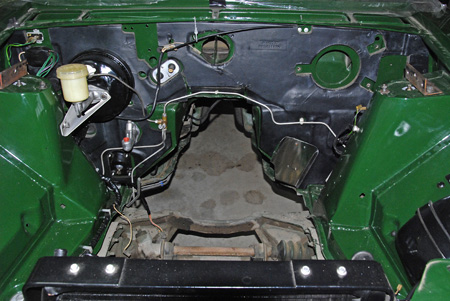Progress slowed a little over the past couple of weeks for I have been waiting for some spares to arrive from the UK. They arrived in the mail today. So now I can proceed to bolt the gearbox onto the engine in preparation for the final up and under manoeuvre which will see the whole engine and subframe assembly moved into the car from below.
I had some problems with my gearbox recently. I lifted it up onto the bench in order to roll it onto its side to check and clean the overdrive filters. It rolled away from me and dropped to the floor breaking the top cover. However I have located a replacement cover locally and the gaskets I need to refit it and the overdrive filter cover came in the parcel received in the mail today.
So progress has been limited to finishing off the engine bay with the construction of a bulkhead exhaust shield out of some stainless sheeting. It is a little wider than the factory fitment and covers the area of the cut out in the bulkhead padding. If it proves to be too large then I will modify it to fit.
Attachment:
 20121112-3639Pw Sprint engine bay.jpg [ 106.34 KiB | Viewed 2454 times ]
20121112-3639Pw Sprint engine bay.jpg [ 106.34 KiB | Viewed 2454 times ]
The two unpainted brackets sitting on top of the suspension turrets are the attachment points for lifting the body during the up and under manoeuvre. Note too that the subframe fitted in this photo, is what I call a mule, for it is an 1850 subframe and it is there for with the front wheels attached and with the whole car sitting on four castored dollies the car can be pushed around the workshop.
The downpipe which attaches to the exhaust manifold has been sent away to be coated with a high temperature ceramic coating and is expected back this week. When that has been fitted then the whole engine assembly will be ready to put back into the car.
I located a source of T2500 7/16 diameter front wheel studs and have turned down the diameter of the head behind the splines so that they fit into the front hubs. When fitted they are marginally shorter than the 3/8 studs but I do not expect this to be a problem.
I have started fabricating a rear axle hub puller for this will allow me to fit the larger studs to the axle hubs. There is some comment on the Forum elsewhere about being able to do all this without removing the rear hub assembly but I might as well fabricate up the tool at this time and do it properly for Murphy’s Law says that I will have to change the oil seals which sit behind the hubs at some stage. It will be used again sometime I am sure.
The next job will be to fabricate a gearbox tunnel cover to suit the Sprint gearbox. My original cover has rusted badly but I have a couple of 1850 covers which I think can be modified. The hole for the gearlever is further back on the Sprint. However I am unsure how the plastic console unit which sits around the gearlever is attached to the rear of the cover. I would be most grateful if someone could post a picture of this area of a gearbox tunnel cover showing this detail for although I have trawled through various threads on the Forum I cannot see the detail I want to see.
On Friday I drive south to Dunedin, some 240 miles away, to have a look at a cache of what has been described as Dead Dolomites. At least four 1850’s of which I think three are automatics, all are parked around a house. The owner had the intention of restoring a couple but has given up and they are to be sent off for scrapping. I hope to rescue one at least which I can then use for parts. One of the four is fitted with Stromberg carburettors so will be a fairly early car and the fourth, a manual, is fitted with an overdrive gearbox.
Perhaps though I could rescue one as my next project although I fancy working on something quite different.